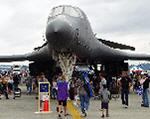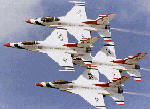
|
Description
| Notes: Prototype for the A-7 upgrade program. | ||
| Manufacturer: | Vought | |
| Base model: | A-7 | |
| Designation: | YA-7 | |
| Version: | F | |
| Nickname: | Corsair II | |
| Designation System: | U.S. Tri-Service | |
| Designation Period: | 1962-Present | |
| Basic role: | Attack | |
| Status: | Prototype | |
Specifications
| Not Yet Available |
Examples of this type may be found at
| Museum | City | State |
| Air Force Flight Test Center Museum | Edwards AFB | California |
| Hill Aerospace Museum | Hill AFB | Utah |
YA-7F on display
Air Force Flight Test Center Museum | Hill Aerospace Museum |
Recent comments by our visitors
| Art Oakland, CA | I'm actually quite familiar with the A-7F. It originally surfaced as part of a Request For Information for the proposed CAS-X program to replace the A-10. A number of proposals were submitted, but USAF seemed to lose interest when it looked like the best option for Close Air Support support would not be the F-16.
This was followed by another study for an "interim" CAS aircraft. Congress, impressed by the A-7 conversion's extremely low cost (less than 1/2 of a new F-16) but high capability and appropriated funds to build two demonstrators and directed USAF to evaluate them. These became the YA-7F. They were built and tested by Vought and then delivered to Edwards AFB where they demonstrated that their performance claims were accurate. Having fulfilled the Congressional requirement and given that the YA-7Fs were not F-16s, USAF then parked the aircraft and lobbied for more F-16s. Although the YA-7Fs used the F100, production A-7Fs would have used either the F100 or the more powerful F110. In either case, and on the YA-7Fs, afterburner was absolutely there, allowing the aircraft to reach M1.4. However, in normal operation, the afterburner would not be needed since even "dry", the F100 or F110 provided over a 1/3 increase in power over the TF41 of the A-7D. The extra "kick" was there when needed. When no 'burner was used on a mission, the A-7F had a substantial range or loiter increase over the already good numbers of the A-7D. If full afterburner was used, you could run it for 120 seconds and still be able to match the A-7D's range/loiter. 04/16/2012 @ 16:36 [ref: 55718] |
| don Vandenberg AFB, CA | Never have heard of this, thanks so much for sharing the information...what a shame this program didn't go forward, talk about a bargain! Lotta performance for less than $5 mil a piece! 09/28/2010 @ 02:04 [ref: 30631] |
| Danny Green Port Wentworth, GA | I was on the crew that built the YA-7F. 06/20/2010 @ 15:26 [ref: 26613] |
| Steve Baudo Arlington, TX | Remember the YA7F well. I worked at Vought Aircraft and was an inspector on that program. Also was flight inspector at Edwards AFB for flight test program. Jim Reed was chief test pilot. Jerry Mumphy was also test pilot.
Steve Baudo 11/07/2006 @ 10:59 [ref: 14683] |
| Guy E. Franklin Montgomery, AL |
In 1985, the. U. S. Air Force Systems Command issued a Request For Information (RFI) for study of the Close Air Support/Battlefield Area Interdiction (CAS/BAI) mission. The U.S. Army and the U.S. Air Force had long been at odds on the subject of close air support for infantry troops and this was yet another chapter in dealing with the problem. The product of the RFI was to be a technical report. In the boldest marketing move ever conceived and executed by the company, the decision was made to respond to the RFI with a proposal for an upgraded version of the A-7. The strategy was to form a marketing "Superteam" which would blitz the customer with a series of presentation featuring the upgraded A-7 as the answer to the CAS/BAI problems, and follow that with a proposal for the airplane. Division President, Phil Greco, a leader with a marketing flare and the courage to attempt the near-impossible, commissioned a blue ribbon group to perform the program. Led by A-7 Engineering Director Betty Pearce, the top woman executive in the aerospace industry, the team launched into a marketing effort that found no peer. After a series of presentations to USAF leaders all over the world, and the submission of an unsolicited proposal to the Air Systems Command, a contract (N33657-87-C-011) was awarded for two prototype airplanes designated the YA-7F. The principal feature of the YA-7F was incorporation of the Pratt & Whitney F100-PW-220 afterburning engine of 20,000 pounds thrust. This required structural modification of the fuselage to add 29.5 inches just forward of the wing, 18 inches immediately aft of the wing and upward rotation of the fuselage aft section to maintain ground clearance. Wing strakes were also added. Other equipment provided was a 60-KVA generator, an On-Board Oxygen Generating System (OBOGS), and revised cockpit controls and displays. Many other improvements were made throughout the airplane The YA-7F first flew in November 1989 with test pilot Jim Read at the controls. Vought proposed to modify 307 Air National Guard A-7D's to the A-7F configuration at a unit flyaway cost of $4.93 million. The two prototypes went on to complete a very successful flight test program at Edwards Air Force Base, but the USAF chose not to put the airplane into production. 08/17/2005 @ 09:16 [ref: 11007] |
| sandy1000 , TX | I LIKE TO "FLY" THE A-7A ON THE SIM (USNF'97).
THE CORSAIR FLYS MUCH LIKE A FIGHTER, ALTHOUGH WITHOUT AN AFTERBURNER. THIS AIRCRAFT, WHILE UN- USUAL IN APPEARANCE, IS BETTER IN EVERY WAY THAN ITS PREDESSESOR (A-4 SKYHAWK)! FOR THE LONGEST TIME, I THOUGHT THE F-8 CRUSADER, AND THIS AIRCRAFT WERE ONE-IN-THE-SAME. THANK YOU FOR PRESERVING THIS BEAUTIFUL EXAMPLE. 03/15/2001 @ 03:00 [ref: 1821] |
Recent photos uploaded by our visitors





